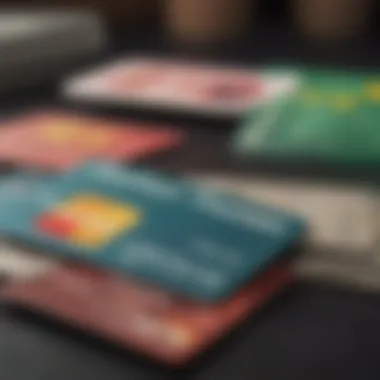Comprehensive Guide to FDIC Prepaid Cards


Intro
In the evolving landscape of personal finance, FDIC prepaid cards have gained traction as a versatile tool for managing money. These cards offer an alternative to traditional bank accounts, catering to a diverse range of users. Whether you’re a student, someone living paycheck to paycheck, or simply looking to budget more effectively, understanding the features and benefits of FDIC prepaid cards is essential.
Unlike conventional bank accounts, prepaid cards allow users to load a certain amount of money onto the card, giving them a set limit to spend. This can help raise financial discipline, making it easier for individuals to manage their budgets. Supported by the Federal Deposit Insurance Corporation (FDIC), these cards also offer a level of protection, similar to what you'll find with standard bank accounts.
This guide will outline the distinctive aspects of these cards, looking more closely at the benefits they provide, the regulatory landscape surrounding them, and what potential users should be cautious about. Hence, it’s vital to examine how these cards fit into the broader financial spectrum and offer insights into making educated choices in personal finance.
Preamble to FDIC Prepaid Cards
The landscape of personal finance has witnessed significant transformations over the years. One particular facet that increasingly garners attention is the realm of FDIC prepaid cards. Understanding these cards becomes essential in navigating the financial world today, whether one is a seasoned investor or just stepping into the economic arena. They serve as a bridge between cash and bank accounts, offering unique functionalities that resonate with various user needs.
Defining Prepaid Cards
Prepaid cards function as a useful alternative to traditional payment methods. They are mainly loaded with a specific amount of funds before use. Unlike credit or debit cards, prepaid cards do not allow users to overspend. When the balance hits zero, no further transactions can be made unless the card is reloaded. This can help with budgeting and avoiding debt, making them quite appealing to those who prefer a rigid spending limit. It's a bit like putting cash in an envelope for different expenses; once the envelope is empty, you know it’s time to stop spending.
Role of the FDIC
The Federal Deposit Insurance Corporation, known as the FDIC, plays a crucial role when it comes to these prepaid cards. They ensure that consumers have some level of protection regarding their funds, as the FDIC insures deposits in member banks. This means if a prepaid card is issued by an FDIC-insured bank, the funds loaded onto that card enjoy similar protections as traditional bank deposits. Thus, users can have peace of mind, knowing their money is ultimately safeguarded.
Market Trends
In recent years, market trends have shown a steady climb in the use and acceptance of FDIC prepaid cards. These cards are particularly becoming popular among younger generations and those seeking financial independence. For instance, with online shopping booming, people are looking for safe ways to manage their funds without needing a traditional bank account.
Moreover, financial technology has evolved tremendously, allowing users to reload these cards easily and make transactions seamlessly. Reports indicate that many consumers prefer the flexibility offered by prepaid cards over conventional banking methods.
As we look ahead, understanding these trends becomes vital; they not only shape how products are viewed but also how they are utilized in everyday life.
"Proactively addressing personal finances can lead to a more secure financial future, especially with tools like FDIC prepaid cards at your disposal."
With this foundational understanding, we can delve deeper into how these prepaid cards operate, their advantages, and potential drawbacks, providing a holistic view of their role in modern finance.
How FDIC Prepaid Cards Operate
Understanding how FDIC prepaid cards operate is crucial for grasping their functionalities and placing them within the larger financial landscape. These cards serve not just as tools for spending but also as instruments this are capable of providing a degree of financial control and security. Examining their mechanics sheds light on how they stand apart from traditional banking options, especially in their unique approach to accessing funds and managing money.
Loading Funds
Loading funds onto an FDIC prepaid card is a pretty straightforward process, yet it brings diverse options to the table. Users can often add money through various channels:
- Direct Deposit: Some employers allow wages to be directly deposited into prepaid cards, which saves time and can mean immediate access to funds.
- Cash Loads: Many retailers, convenience stores, and even certain dpoits allow cash loads, making it quite convenient for those who prefer using physical currency.
- Bank Transfers: For users familiar with traditional banking, moving money from personal accounts to their prepaid cards through transfers is a common method.
This flexibility ensures that individuals can select a method that aligns with their lifestyle and preferences. However, it’s important to be mindful of applicable fees during loading, as these can vary depending on the service provider.
Using the Card
When it comes to actually using an FDIC prepaid card, the experience can closely mirror that of a debit or credit card. Once the card is loaded, holders can wield it for everyday purchases, be it at grocery stores, online retailers, or on services like ridesharing apps. One significant advantage here is the capability to help users stay within budget. Since prepaid cards don't allow overdrafts, spending ultimately is limited to the amount loaded onto the card, which can foster improved spending discipline.
Furthermore, these cards can be used to make recurring payments, such as subscription services, which sends a clear signal that these tools integrate comfortably into modern financial habits. However, not all merchants may accept prepaid cards, so checking acceptance beforehand is a good idea.
Reload Options
Reloading an FDIC prepaid card is just as important as the initial loading, as continued access to funds is key. Various reload options can keep the card functional:
- Automatic Reload: Some cards offer the ability for automatic reloads, linking to a checking account and allowing for seamless funding.
- In-person Reloading at Locations: Retail partners often provide reload services at specific locations, which can be both a convenience and a hassle, depending on proximity.
- Online Reloading: Users can conveniently transfer funds online through linked accounts, adding a layer of flexibility to how and when money can be accessed.
Advantages of FDIC Prepaid Cards
Understanding the advantages of FDIC prepaid cards is crucial for those looking to navigate their financial options with clarity. Offering a variety of features, these cards stand out in the vast landscape of financial tools, catering particularly to individuals who value straightforward and effective spending solutions. Here are some key benefits:
Financial Accessibility
One significant advantage of FDIC prepaid cards is their financial accessibility. People from different walks of life, especially those who may not have traditional banking options, can easily obtain these cards. This aspect is particularly beneficial for individuals who might face hurdles in securing a bank account, whether due to past issues or simply not having the necessary documentation. With just a valid form of identification, a prepaid card can be acquired, thereby offering a
reliable alternative to cash transactions, enabling users to engage in modern financial systems without the complexities that often accompany traditional banking.


Moreover, prepaid cards do not require a credit check, making them ideal for folks who are new to credit or aiming to rebuild their credit history. This accessibility opens doors to various financial transactions, such as online shopping or purchasing services that might be out of reach without a typical bank account.
Budgeting and Control
FDIC prepaid cards also shine in terms of budgeting and control. Users can only spend the amount loaded onto the card, which makes it an effective tool for managing finances. In today’s economy, where overspending can be a regular pitfall, having a prepaid card sets clear spending boundaries.
Tracking spending becomes a breeze, as many issuers offer online portals or mobile apps that display transaction histories in real time. Users can set up alerts for transactions, giving them further control and insight into their financial habits. For families or individuals trying to adhere to a particular budget, this hands-on management can lead to better financial health:
- Prevention of overspending: Users are limited to their card balance, so they can only spend what they have.
- Goal setting: Individuals can load certain amounts saved for specific expenses, like a vacation or holiday shopping.
- Financial education: For younger users or those new to financial systems, using a prepaid card can be a stepping stone towards understanding financial responsibility.
Built-in Safety Features
Safety is another hallmark of FDIC prepaid cards. Unlike carrying cash, which can easily be lost or stolen, these cards offer a layer of protection. If a card is lost or stolen, users can report it and, in many cases, have their funds recovered. Furthermore, many prepaid cards provide the same fraud protections as credit and debit cards, reducing the risk of financial loss from unauthorized transactions.
These cards often come with:
- Identity protection services: Alerts for suspicious activity can save users from significant losses.
- Emergency cash access: In the event of loss or theft, some card providers offer assistance that can provide access to funds through emergency temporary cards.
- PIN protection and security features: Users can set up a Personal Identification Number (PIN), ensuring they are the only ones who can access their funds.
In a world where identity theft and fraud are rampant, these built-in safety features of FDIC prepaid cards can offer peace of mind, encouraging users to spend and manage their funds without constantly peering over their shoulders.
Overall, the advantages of FDIC prepaid cards make them a compelling choice for individuals looking to enhance their financial fluidity while maintaining control, safety, and accessibility.
Drawbacks and Considerations
When it comes to FDIC prepaid cards, while there are shining benefits, one cannot overlook the drawbacks and considerations that accompany their use. Understanding these aspects can help users navigate the complexities associated with prepaid options and make informed choices. This section dives into various issues, focusing on fees, consumer protections, and transaction limitations.
Fees Associated
One of the most visible drawbacks of using FDIC prepaid cards is the potential for various fees. Unlike traditional debit or bank accounts that might offer free transactions, prepaid cards often come with their own set of costs. Here are some common fees you might encounter:
- Loading Fee: This is charged when you add money to the card. Depending on the service, the fee can vary, and some cards even advertise zero loading fees as a promotional tactic.
- Monthly Maintenance Fee: Many prepaid cards have this fee, which can chip away at your balance over time. It’s best to keep an eye on this, as it can add up.
- ATM Withdrawal Fee: If you plan to withdraw cash, be prepared for potential fees. These costs may differ based on the ATM you use—some may charge higher than others.
- Transaction Fees: Certain prepaid cards will charge when you use them for purchases, especially if they are used outside the network.
In the broader context of personal finance, these fees can hinder overall usability, especially for users intending to budget tightly. Calculating all charges before opting for such cards is crucial to avoid nasty surprises.
Limited Consumer Protections
While FDIC prepaid cards do come with coverage under the Federal Deposit Insurance Corporation, it's vital to recognize their limitations. They don’t offer the same level of consumer protections as traditional credit or debit cards. Here are some issues that may arise:
- Fraud Liability: Should your card be lost or stolen, the process for reimbursement can be complex. Unlike credit cards that allow for swift dispute resolutions, prepaid cardholders may face delays and additional hurdles, potentially leading to financial strain.
- No Chargeback Rights: If a transaction goes awry, your ability to initiate a chargeback can be limited. This can hinder efforts to recover funds in case of disputes with merchants.
- Limited Traceability: The anonymity that some users prefer with prepaid cards can also work against them when resolving issues. Without a paper trail, proving transactions might become more complicated.
These limitations might deter some users, particularly those who prioritize security and protection in their financial transactions. Knowing these intricacies can guide users to weigh their options better when considering prepaid cards for daily use.
Restrictions on Transactions
Another crucial aspect to consider is the restrictions tied to prepaid cards. They aren’t as flexible as traditional banking products. Here’s a closer look at some common limitations:
- Spending Limits: Many prepaid cards impose spending limits, meaning users might not be able to utilize the full balance in one go. This could become an inconvenience during larger purchases.
- Merchant Restrictions: Some cards may not be accepted by specific merchants, particularly those that don’t take prepaid options or require cardholders to link accounts.
- International Use: Traveling abroad? Be cautious. Not all prepaid cards work internationally, and when they do, the exchange rates and foreign transaction fees can vary significantly.
For users planning to incorporate prepaid cards into their financial habits, these restrictions should be considered seriously. Understanding what limitations accompany these cards can help in crafting a well-rounded approach to managing finances.
Ultimately, while FDIC prepaid cards offer distinct advantages, being aware of the drawbacks ensures a more harmonious relationship between your financial needs and the tools you decide to use.
Who Should Use FDIC Prepaid Cards?
Understanding the audience for FDIC prepaid cards is critical. These financial tools are not one-size-fits-all. Various segments of the population can benefit from them, though for different reasons.
Target Demographics
- Low-to-moderate income individuals: For many people who operate on tight budgets, FDIC prepaid cards can serve as an alternative to traditional banking services. They do not require a credit check, making them accessible to those with poor credit history or without banking experience. Since there is no risk of overdraft, users can only spend what they load onto the card, promoting financial discipline.
- Students: Young adults often find themselves in need of a financial tool that is easy to manage. Prepaid cards are perfect for students as they can control their spending while learning financial responsibility. Parents can load money onto these prepaid cards for allowances, easing the transition into independence.
- Travelers: When embarking on international adventures, not having to carry large sums of cash is a big safety plus. Prepaid cards offer a way to access funds abroad without incurring ATM fees associated with debit or credit cards. It’s like having a bank in your pocket, wherever you go.
- People with limited access to banking: In rural areas or regions underserved by banks, prepaid cards offer individuals a secure option for handling money. This can be vital for locals who may have to travel long distances to reach a bank.
- Gift-givers: Prepaid cards have become a popular choice for giving gifts. They offer the recipient flexibility—allowing them to purchase what they truly want, instead of receiving items that might end up collecting dust.
Potential Use Cases
FDIC prepaid cards can be adapted for a variety of scenarios, making them useful for many people. Here are some practical applications:
- Setting Budgets: Individuals can allocate funds to specific categories (like groceries, entertainment, etc.) by loading different amounts onto various cards; it's like having a mini budget for each purpose.
- Online Shopping: As e-commerce grows, so do concerns around identity theft. Using a prepaid card for online purchases can limit exposure as it’s not directly linked to the user’s bank account. If there’s any fraudulent activity, it’s restricted to the balance on that card.
- Emergency Fund: Keeping a prepaid card loaded with a small amount for emergencies can give peace of mind during unexpected situations—like car troubles or medical emergencies. This is separate from cash that others might want to take for daily expenditures.
- Travel budgets: Especially useful for budgeting while traveling, prepaid cards can track spending abroad without the hassle of exchanges or fluctuating rates.
"Prepaid cards shine in budgeting, providing a unique way for users to engage with their finances."


Comparison with Other Financial Products
Understanding the distinctions between FDIC prepaid cards and other financial products is key when evaluating their role in personal finance. Each product serves different functions, offers unique benefits, and has its own quirks that may appeal to various consumer needs. Grasping these comparisons not only aids in selecting the appropriate tool for managing funds but also assists in comprehending how these products fit within broader financial strategies.
Prepaid Cards vs. Debit Cards
Prepaid cards are often pitted against debit cards, yet the two are not identical. While debit cards draw directly from a linked bank account, prepaid cards require users to load money onto them before usage, like a gift card but for everyday spending.
Key Differences:
- Funding Source: Debit cards have a bank account tethered to them, which means overdrafts could occur if a user isn't mindful. Prepaid cards, on the other hand, can't be overdrawn since they only allow transactions up to the loaded amount.
- Fees: Debit cards can sometimes come with monthly maintenance fees, whereas prepaid cards might charge for loading funds or withdrawing cash, making it crucial to choose wisely.
Ultimately, the choice could depend on spending habits. For someone who wishes to stick to a budget and avoid debt, prepaid cards offer a more controlled environment.
Prepaid Cards vs. Credit Cards
When considering prepaid cards next to credit cards, the differences become strikingly apparent. Credit cards provide a revolving line of credit that can contribute to building one's credit score, while prepaid cards do not report usage to credit bureaus, effectively keeping users outside the credit system entirely.
Considerations include:
- Interest Rates: Credit cards often come with hefty interest charges if balances are not paid in full each month. Prepaid cards, conversely, have no interest rates because users spend only what they have loaded.
- Consumer Protections: Credit cards generally offer more robust protections against fraud, including zero-liability policies for unauthorized transactions. In contrast, prepaid cards may lack the same level of security, leaving users vulnerable if their cards are lost or stolen.
For those who prioritize building credit and want fraud protection, credit cards are a favorable option, while prepaid cards suit those wanting strict control over their spending.
Prepaid Cards vs. Bank Accounts
Lastly, drawing a comparison between prepaid cards and traditional bank accounts reveals significant differences in functionality and user experience. Bank accounts typically offer a wider range of services, such as direct deposits, check-writing, and overdraft protection. Prepaid cards, on the flip side, are much more straightforward, focusing primarily on payment functionalities.
Notable Elements:
- Accessing Funds: Bank accounts allow for seamless access, including ATM withdrawals, electronic transfers, and checks. Prepaid cards might limit users to using their balance for purchases or specific withdrawal outlets, potentially causing some inconvenience.
- Fees and Minimum Balances: Bank accounts often require minimum balances to evade monthly fees, whereas prepaid cards may charge fees for loading funds, making them less appealing for individuals who prefer to keep funds flexible and accessible.
Choosing between a prepaid card and a bank account can hinge on lifestyle and financial needs. Those desiring full banking services might find a bank account more comprehensive, while individuals seeking simplicity might lean toward prepaid options.
"Selecting the right financial tool depends on understanding not just how you spend, but how each option aligns with your broader financial strategy."
In summary, FDIC prepaid cards carve out a niche among financial products. Each comparison showcases that the decision-making process should not be taken lightly, as aligning them with one’s personal financial habits is vital.
Regulatory Overview
Understanding the regulatory landscape surrounding FDIC prepaid cards is crucial for anyone looking to navigate this financial product. Regulations can shape the way these cards operate and influence consumer protections and overall user experience. It's important to grasp not just what these regulations are, but also why they matter, especially for users who might lean heavily on prepaid cards for their financial needs.
FDIC Coverage Explained
The Federal Deposit Insurance Corporation, or FDIC, plays a vital role in ensuring the safety of money held in financial institutions within the United States. For users of prepaid cards, the FDIC coverage is a significant factor. Many prepaid cards are issued by banks that are insured by the FDIC, which means that your funds are protected against bank failures up to a certain limit, typically $250,000 per depositor per insured bank.
This coverage brings a peace of mind to users, distinguishing FDIC prepaid cards from other financial options that may not offer such security. However, not all prepaid cards come with this insurance. It is essential to verify if a prepaid card is FDIC-insured. When choosing a prepaid card, look for the FDIC logo or confirmation from the issuer regarding the insurance status.
"FDIC coverage is a security blanket for several consumers using prepaid cards, providing reassurance that their funds are safe even in challenging economic times."
Consumer Financial Protection Bureau Oversight
Another layer of regulatory oversight comes from the Consumer Financial Protection Bureau (CFPB). This agency was established to safeguard consumer interests in financial markets. Their regulations extend to prepaid cards, ensuring that consumers are well informed about fees, terms, and conditions associated with such products.
Prepaid card providers must disclose all costs upfront, making it easier for users to make informed decisions. This scrutiny from the CFPB also helps to guard against deceptive practices, ensuring fairness in marketing and usage. Additionally, the CFPB has the authority to investigate complaints and enforce regulations, providing a level of accountability in the prepaid card market. Users should utilize CFPB resources to familiarize themselves with their rights, which can have profound implications when issues arise.
State vs. Federal Regulation
The regulation of prepaid cards doesn't exist in a vacuum; it's influenced by both state and federal policies. While federal regulations like those from the FDIC and CFPB provide a baseline of consumer protection, various states have their own regulations that can further affect how these cards are issued and used.
For instance, some states may impose stricter limitations on fees that card issues can charge or require additional disclosures regarding card usage. This can lead to variability in consumer protections depending on where the user resides. Understanding local regulations is critical, as they may provide extra safeguards or impose specific limitations that you should be aware of before committing to a card.
- Familiarize yourself with your state's regulations regarding financial products.
- Check if your prepaid card provider gives any additional protections or benefits based on the state's law.
Ultimately, everyone interested in FDIC prepaid cards should understand the regulatory environment. Being informed about coverage limits, oversight from governing bodies, and variations in state regulations can help users navigate the options, ensuring they select cards that meet their needs safely and effectively.
Practical Applications in Daily Life


In the world of finance, understanding how tools can be utilized in everyday scenarios is essential. FDIC prepaid cards are more than just plastic; they represent a flexible approach to managing money. These cards serve varied functionalities, making them suitable for several practical applications in daily life whether for travel, online shopping, or gifting purposes.
Using Prepaid Cards for Travel
When embarking on a trip, having accessible funds while ensuring one’s financial safety is top of mind. This makes FDIC prepaid cards an attractive option for travelers. Unlike traditional credit cards, which often come with hidden fees or foreign transaction costs, prepaid cards allow users to load a set amount before their journey. By doing so, travelers can effectively budget their spending.
Moreover, using a prepaid card minimizes the risk of overspending. Once the balance is exhausted, you simply won't be able to use the card anymore until it is reloaded, which encourages more mindful spending.
Additionally, many prepaid cards come equipped with features like ATM access for cash withdrawals overseas, and they offer the advantage of being FDIC insured. This means that your funds are protected up to the required limit.
Prepaid Cards for Online Purchases
With the surge of e-commerce, online shopping has become a staple in many households. However, it also brings potential risks such as fraud and overspending. Integrating FDIC prepaid cards into online transactions can help alleviate these issues.
- Security: Prepaid cards can be dedicated just for online purchases. This keeps your primary banking information away from potential threats, as you do not have to link your checking or credit card accounts.
- Budget Management: Setting a limit on how much you load onto a prepaid card helps in controlling online spending. Once the funds are drained, there’s no temptation to keep buying.
- User-Friendly: Many prepaid cards can easily be linked to various online accounts, acting like a typical debit or credit card without the risks associated with high credit limits.
Gifting and Allowances
When it comes to gifting, FDIC prepaid cards can be a game changer. Instead of dealing with the complexities of finding the perfect gift, offering a prepaid card allows the recipient to choose exactly what they want.
- Flexible Gifts: Whether for birthdays, holidays, or special occasions, a prepaid card can suit anyone’s preferences. Recipients can utilize it as they see fit, enhancing the overall gift experience.
- Allowances for Kids: Parents can leverage prepaid cards to teach children about financial responsibility. By loading a set amount each week, children learn to manage their funds and make decisions about spending, from saving for a toy to understanding the value of money.
- Control: Parents can monitor the expenses on the prepaid card, ensuring their children spend it wisely while also protecting themselves from overspending.
In summary, FDIC prepaid cards offer practical solutions for travel, e-commerce shopping, and gifting, providing a compliant and responsible approach to managing finances.
Incorporating prepaid cards into one’s financial practices can lead to better budgeting and less financial stress, making it an ideal tool in everyday life.
Future Trends in Prepaid Cards
The payment landscape is constantly shifting, and prepaid cards are no exception. As we dive into the future trends around these financial tools, it's crucial to recognize how they are evolving to meet consumer needs and technological advancements. Understanding these trends allows users—from casual spenders to seasoned investors—to capitalize on new opportunities. The following sections unfold key facets of this transformation, highlighting innovative technologies, market shifts, and changing consumer preferences.
Technological Innovations
In today’s digital age, technological innovations are reshaping how prepaid cards function. Financial technology, or fintech, has significantly affected how these cards integrate with other platforms. For instance, many prepaid cards now offer seamless app integration, where users can manage their funds, view transaction history, and even set budgets right from their smartphones. These apps usually provide real-time notifications alerting users on spending habits.
Moreover, features like virtual card numbers are becoming more common. This technology allows users to generate a temporary card number for online purchases, enhancing security and minimizing fraud risks. As cybersecurity concerns grow, such innovations will likely become the standard.
"The evolution from plastic to digital is a sign of the times; those who adapt will thrive."
Market Projections
Looking into the future, market projections regarding prepaid cards suggest a steady growth trajectory. Analysts predict that the overall prepaid card market is set to burgeon, driven mainly by increasing adoption among various demographics. Particularly in the aftermath of the pandemic, many people are turning towards prepaid cards as a means of budgeting.
Reports indicate that consumers aged 18-34 are particularly inclined to embrace prepaid card solutions. It's thought that ease of use, alongside the ability to control spending without the risks associated with credit cards, are significant factors. Furthermore, as businesses increasingly adopt prepaid cards for employee benefits and payroll disbursements, demand is expected to surge.
Unconventional partners are also stepping into this market. Collaborations between tech startups and financial institutions might lead to unique prepaid solutions tailored to niche audiences. Therefore, staying equipped with knowledge on these shifts could provide substantial advantages.
Evolving Consumer Preferences
As consumer behaviors shift, so do the preferences surrounding prepaid cards. Once viewed as a last resort for those without traditional bank accounts, these cards are becoming recognized as a valid budgeting tool among a broader audience. People are seeking flexibility, and prepaid cards are fitting the bill by offering features like instant loading and customizable limits.
Today’s consumers desire transparency, efficient customer service, and the ability to control their financial decisions actively. Many users appreciate the lack of credit checks and the straightforward fee structures associated with prepaid cards. Additionally, consumers are increasingly gravitating towards environmentally friendly solutions, prompting companies to explore biodegradable or digital alternatives to traditional plastic cards.
With an ever-evolving market landscape, it's also notable that consumer education is becoming vital. As more information becomes accessible online, individuals are empowered to seek out products that suit their specific needs and preferences, further driving the shift toward personalized and innovative prepaid options.
Closure
In summarizing the facets of FDIC prepaid cards, one appreciates the unique position they occupy in the financial landscape. These cards serve multiple purposes, bridging the gap between traditional banking accounts and cash usage.
Summary of Key Insights
FDIC prepaid cards come with certain features that stand out:
- Insured Protection: As these cards are linked to FDIC-insured institutions, cardholders gain the peace of mind of knowing that the funds they're holding remain secure up to the insured limit.
- Cost-Effective: Many users find that these cards can help avoid overdraft fees and maintain better control over spending due to their prepaid nature.
- Accessibility: Particularly important for the unbanked or underbanked populations, these cards open doors to financial services that may otherwise be unavailable.
The prepaid card can really be a financial lifesaver for those who are still trying to navigate their way through the banking system.
Another key takeaway is that users have to be mindful of the associated fees and limitations. These factors can sometimes overshadow their benefits, making it essential for potential users to weigh their options carefully.
Final Thoughts on Usage
Adopting FDIC prepaid cards can be a wise decision depending on individual needs. They cater particularly well to:
- Travelers: Using a prepaid card for overseas trips can reduce the hassle of currency conversion and foreign transaction fees.
- Budgeters: These cards allow individuals to put a set amount of money away and manage their spending without high-interest debts creeping in, an ideal situation for those who struggle with impulse purchases.
- Gifting: Rather than handing out cash, a prepaid card provides a more thoughtful gift solution, allowing recipients to spend it as they see fit.















